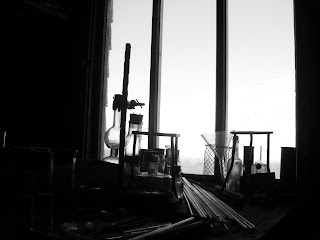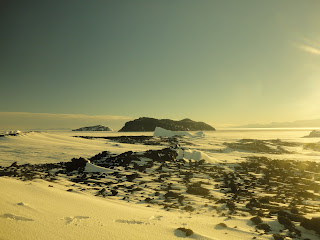Boondogle: Translation, an Antarctica word, probably made up, that means you go do something that has nothing to do with your job for a day. And OH DANG ARE THEY FUN!!! I have ZERO training in the world of diving but low and behold, I found myself sitting in the back of a funky vehicle called a pistonbully, rumbling along toward a dive shack.... With my camera in tote and my fellow diving attendent, Ross alongside, we headed out of McMurdo about 30 minutes with Diver Rob and Grantee Henry Kaiser (guess where you've heard that last name before....yep.) Ross became an instant friend as we embarked on this adventure together. The dive shack looked like a tiny house in the middle of the icy tundra. Inside, it was warm and fully stocked with juice boxes and snacks. In the middle, a hole that lead down 12ft to the 28degree ocean water. We were approx. 52 ft. from the ocean bottom in this location. Rob and Henry were on a mission to collect some samples for a study and Ross and I were there to help them with all of their gear. In order to get out of the dive hole, someone has to drag their gear out of the water from the floor level (our job) and get their gloves attached to their space-age wet suits. It was awesome! The icing on top of a wonderful day was a visit from a BEAUTIFUL Weddell Seal..... It was an epic moment for me.
Sunbathing Weddell Seal - not dead.
This one was watching me.... I'd like to think she was smiling for me and that her mouth isn't just shaped that way...
My epic moment. Praise God for zoom! Weddell Seals are my new favorite animal in the whole world. They are truly fascinating animals. Their favorite foods are cod and silverfish. They live harmoniously with this extremely harsh continent. Weddell Seals can hold their breath for 45 minutes and dive 2,000ft beneath the surface. When they need oxygen, they can open their mouth so wide that their bottom jaw becomes parallel with the top of their mouth and they use their teeth to saw through the ice....sometimes feet of ice. They punch through the ice and jump out to soak up the sun, wind, snow, or whatever the weather is. Their layers of fat keep them warm and their unique combination of fuzz and smooth skin repels water off of their rounded bodies. September and October is pup season for Weddell seals and I've seen a few of the little ones from a distance. They are remarkable animals.



















































